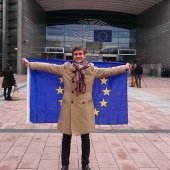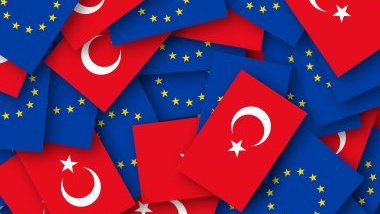Baltic countries, between Russia and Europe
The Baltic states’ belonging to the European space isn’t a given. Throughout modern history, these countries have long been under Russian rule, first as provinces of the Russian empire and then, after independence in the interwar period, as Soviet republics – rather than simply as countries of the ‘Eastern Bloc’, like most other countries in Central and Eastern Europe.
The presence of significant Russian-speaking minorities (6% in Lithuania, 27% in Latvia and 25% in Estonia), and of Orthodox Christians (notable minorities in Estonia and Latvia), the proximity of the Estonian language to certain Finno-Ugric languages spoken in Russia, as well as the Russian exclave of Kaliningrad located between Poland and Lithuania, attest to the cultural ties that this region has with the Russian world.
But the Baltic states’ closeness to Europe is just as indeniable. Located on the Baltic Sea, they have historical links to Northern European countries at the shores of the Baltic and the North Sea, in particular the Nordic countries but also Germany. Like the latter, Estonia and Latvia are mainly protestant [1], whilst Lithuania is predominantly Catholic because of its geographic and historical proximity to Poland. Finally, and perhaps more importantly, these countries – which already declared independence before the collapse of the USSR – are the only former Soviet republics to have turned away from the Russian sphere of influence to join the NATO in 2003 and the EU in 2004.
Ambivalent relationship: mistrust behind cooperation
The relations between the Baltic states and Russia remain complex. On the one hand, the Baltic countries have significant economic relations with Russia, as well as other ex-Soviet countries like Kazakhstan. This is especially true of port cities like the Latvian capital Riga and the Estonian capital Tallinn.
Since 2004, European funds have been allocated to numerous cross-border cooperation projects with Russia and Belarus, another ex-Soviet state. Baltic countries have invested themselves in these projects, keen to make the most of the remote geographical location vis-à-vis the rest of Europe and to overcome their economic difficulties. Moreover, the Baltic states compete over Russian trade with Finland. Russia is the biggest trading partner of Lithuania, and the third-biggest partner of Estonia and Latvia.
On the other hand, beside this (unequal) cooperation one can notice a lack of trust, or even suspicion. From Russia’s viewpoint, the Baltic countries are a part of its sphere of influence in the same way as Ukraine, Belarus or Kazakhstan, whilst Baltic states themselves are very attached to their national sentiment in their relations with what long was an occupying power.
After regaining independence, accession to NATO and its mutual defence system was an even higher priority for these countries than EU membership was. The NATO enlargement, of course, has changed a lot from the Russian perspective, as the country now has land borders with NATO member states. There is a real fear of Russian influence or even expansionism. In losing the Baltic states, Russia has also lost a big part of its access to the Baltic Sea. (From this viewpoint, cooperation with Baltic ports is in Russia’s strategic interest.) The Russian annexation of the Crimea in 2014, or the recent conflict between Russia and Ukraine in the Sea of Azov, have only strengthened these fears.
The ‘Russian threat’ as seen by the Baltic countries
In the recent years, Baltic states’ disquiet has only grown. After the Russo-Ukrainian crisis in 2014, the NATO has stationed battalions in Estonia, Latvia and Lithuania. For the NATO, this is a back-up measure, while for the Baltic countries it’s an absolute necessity. In 2017, there were 1,000 men under British command in Estonia, 1,000 under Canadian command in Latvia, and 1,000 under German command in Lithuania. The French army is also getting increasingly involved: French soldiers have participated in the Baltic Air Policing mission six times since 2004, and within the Lynx mission, there have been French soldiers stationed in the three Baltic states since 2016.
Between 2014 and 2018, Latvia and Lithuania doubled their military budgets, reaching the NATO target of 2% of the GDP, while the Estonian defence budget also exceeds the 2% target. Baltic countries highlight Russian President Vladimir Putin’s authoritarianism and Soviet nostalgy, and urge their Western allies not to appear naive.
But an annexation or a direct attack by Russia against a NATO member state is too risky and therefore unlikely. Baltic states, however, fear another type of aggression: hybrid warfare. Hybrid warfare consists of interference and destabilisation in another country with the help of means like stoking internal conflicts (by supporting pro-Russian opposition groups), spreading of pro-Russian media and disinformation, destruction of infrastructure, and cyber attacks.
These techniques were used by Russia during the Ukrainian crisis, and the Baltic states have been alerting the EU and the NATO on this topic for years. In 2017, the Foreign Ministers of the three countries, visiting Washington, implored their allies not to underestimate the Russian threat that they said was ‘unprecedented in the past thirty or forty years’. The Latvian Foreign Minister Edgars Rinkevics said that he thinks ‘we have seen in the last three or four years that democratic nations are the target of attack’. Already in 2007, the Estonian web had witnessed a wave of cyber attacks at the moment when the government had decided to relocate the Bronze Soldier monument dedicated to the Red Army, provoking the anger of Russian minority and a diplomatic crisis with Moscow.
This affair illustrates the delicate situation of Baltic Russians. Indeed, even if the coexistence is relatively stable, anti-Russian suspicion exists among certain nationalists, and these minorities have been excluded and discriminated, a fact that Russian media have not failed to highlight. Moreover, Baltic Russians, and even more so those living in the Kaliningrad exclave, have viewed the Baltic countries’ EU accession as an additional rupture from Russia.
The protection of Russian minorities in neighbouring countries (Baltic states, Ukraine, Moldova, Kazakhstan) is an issue of utmost importance to Putin’s Russia, and the minorities may be used as a political instrument. In 2012, a referendum seeking to make Russian one of the official languages of Latvia (a proposal voted down by 75% of people) had been interpreted by nationalists as an attempt at Russian interference, while Moscow viewed it as a “call for help” by Latvia’s Russians. The risk was to end up in a vicious circle of mutual distrust, with Baltic Russians becoming more and more pro-Russian and the majorities increasingly anti-Russian, leading to social tensions and even violence.
European aid
Since the collapse of the USSR, all ex-communist countries of Eastern and Northern Europe have been clearly Atlanticist, relying on NATO protection, as well as sovereignist. Clearly, the Baltic states are currently the EU member states that feel the most threatened by Russia.
Faced with this situation, can Europe and especially the EU play a significant role? Integrated European defence remains notoriously weak and incomplete because of differences between countries, and the refusal to give up on sovereignty in military matters. Advances have been made, but they have been timid. In this situation, the Baltic countries deepen their strategic relations with certain countries, for example France, but it is clear that aid coming from the EU won’t be of military kind.
The EU can, therefore, mainly give economic, political and social support. Despite the rapid economic growth of the 2000s that once gave the three countries the nickname of “Baltic tigers”, the Baltic states remain among the least wealthy EU member states in terms of GDP and GDP per capita. Even though the countries receive little European funding, because of their small population the Baltic countries are among EU member states receiving the most EU funding per inhabitant.
Baltic countries also rely on connections and entry into European networks to pull away from Russian influence. In 2016, Lithuania was plugged into the European electricity network via Poland, and Estonia and Latvia plan joining by 2025, thereby abandoning their dependence on Russian grids.
Moreover, when properly managed, regional aid could contribute to preparation for the eventuality of hybrid war, but also to pacifying social tensions. It seems imperative for the EU to place border regions at the centre of its considerations, and to help these regions combat against the internal and external conflicts that threaten them.








Follow the comments: |
|
